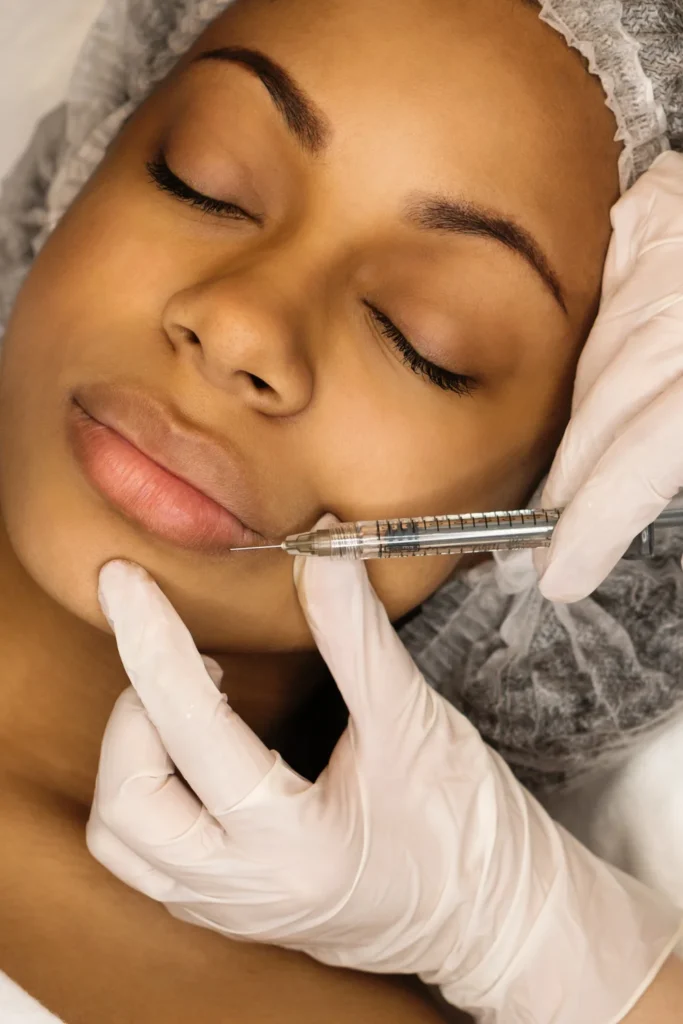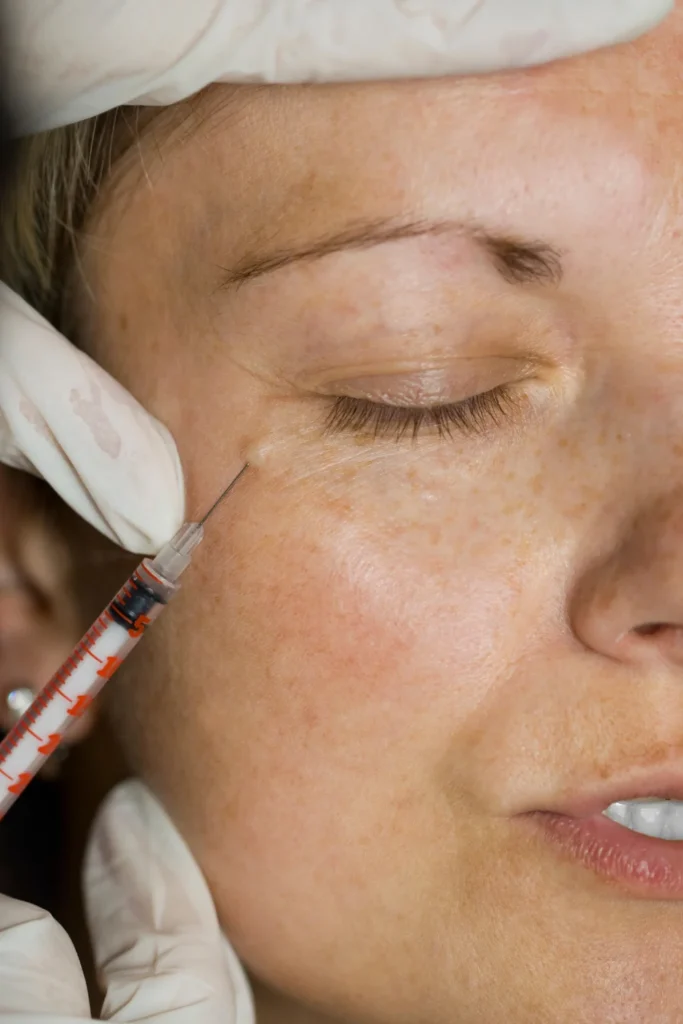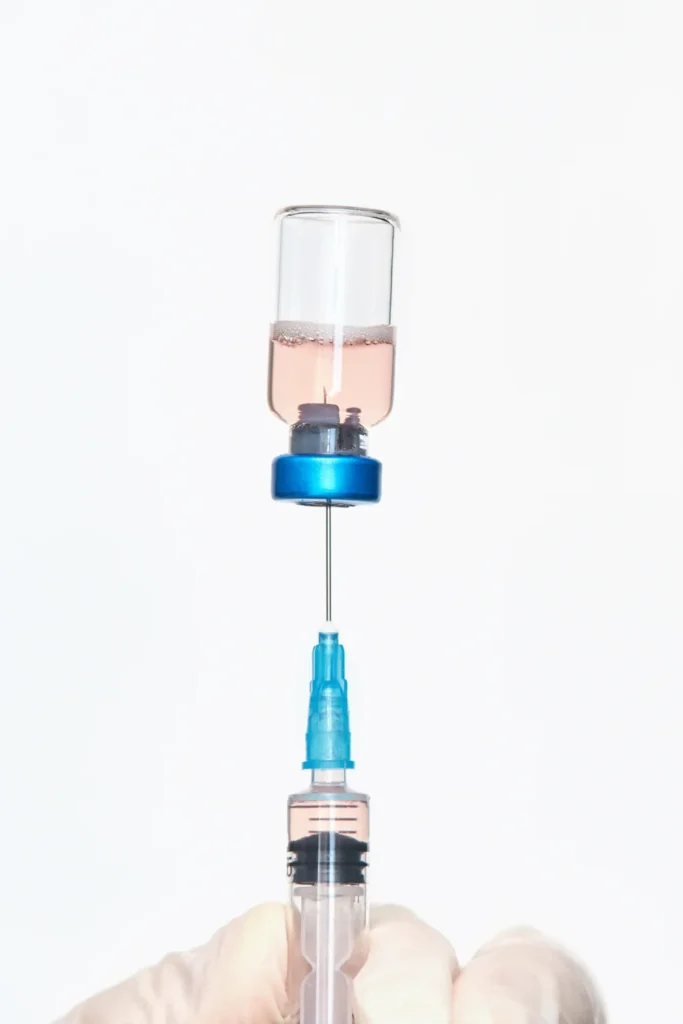A millimeter can make the difference between natural beauty and obvious intervention.
Think of your face as a dynamic canvas. Bone, fat, muscle, and skin move together, creating shadows and highlights that shift with every expression. Modern injectable treatments should work within this intricate system, not against it.
Today’s techniques target the subtle interplay of facial architecture, using precise amounts of product in strategic locations. It’s science meeting artistry, anatomy fusing with aesthetics.
Mastering the art of injectables requires an aesthetic eye, a steady hand, and a deep understanding of aging patterns and facial balance. Whether smoothing a forehead or restoring cheek volume, the success of these procedures depends on precision, experience, and vision.
Natural looking injectables enhance inherent beauty – continue reading about the different types of injectables so you can learn what is available to help you attain your aesthetic goals.
Related: What is a Sofwave Device?
The Art of Injectables: A Comprehensive Overview
What Defines the Art of Injectables

Injectable facial treatments represent a sophisticated intersection of science, aesthetics, and personalization. The art of injectables lies in knowing how much, where, and why — not simply in the ability to administer a product.
Every face is structurally and proportionally unique. A successful injectable facial treatment will result in an outcome that respects that uniqueness so the treatment enhances natural features rather than altering them.
The Role of Customization in Injectable Procedures
There is no single formula that works for all patients. Facial contours, muscle activity, and skin condition vary greatly. A plastic surgeon skilled in injectables evaluates these variables to determine the most suitable approach for each individual. The objective is not to create uniformity, but to maintain character while addressing areas of concern.
How Aesthetics and Anatomy Guide Each Approach
A strong understanding of facial anatomy is essential. Injection points must be selected with full knowledge of vascular structures, muscular patterns, and fat distribution. This anatomical insight ensures not only effective results but also patient safety.
Equally important is an aesthetic sensibility. The art of injectables understands facial balance involves judgment and experience. The best outcomes reflect this balance between anatomical knowledge and artistic perception.
Differences Between Cosmetic Injectables and Surgical Options
Injectables offer subtle refinement without the commitment of surgery. They are temporary, adjustable, and often performed without general anesthesia or extended recovery.
However, their limitations must also be understood. While they can address early signs of aging or asymmetry, they cannot replicate the results of a surgical procedure when more extensive correction is required.
The choice between injectable and surgical options is not binary. A comprehensive consultation allows patients to explore which path — or combination — best suits their needs and expectations.
Common Injectable Facial Treatments and Their Uses
Neuromodulators and Its Targeted Applications

Neuromodulators such as Botulinum toxin, commonly referred to by its brand name Botox®, and abobotulinumtoxinA (brand name Dysport®) are used to reduce the appearance of dynamic wrinkles — those formed by repetitive muscle movement. These include forehead lines, frown lines between the brows, and crow’s feet.
The technique relies on controlled muscle relaxation. Dysport® or Botox® injection points interrupt the signal between nerve and muscle, allowing the skin to appear smoother while maintaining facial expression when applied properly. The result is a more rested, refreshed appearance without compromising authenticity.
Dermal Fillers for Volume Restoration
Volume loss is a hallmark of facial aging. Dermal fillers are injectable gels, typically composed of hyaluronic acid, designed to restore structure in areas such as the cheeks, under-eyes, lips, and jawline.
When placed with care, fillers can subtly lift, smooth, and contour the face. The intention of dermal filler techniques is not to inflate but to recreate volume that has naturally diminished. Placement depth, product density, and injection pattern all influence the final outcome — which is why product selection alone does not determine success.
Skin Boosters and Bio-Revitalizers
Some injectables focus less on contouring and more on enhancing skin quality. These include treatments that hydrate from within, stimulate collagen, and improve texture. Skin boosters are typically used across the cheeks, neck, and décolletage to restore a more luminous and supple appearance.
While not intended for shaping or lifting, these treatments play a valuable supporting role in a broader aesthetic plan. They improve skin resilience and radiance — essential components of youthful appearance.
Biostimulators
Unlike traditional fillers, biostimulators like Sculptra® encourage the body’s own regenerative processes and stimulate the body’s natural collagen production and elastin to improve skin strength, flexibility and smoothness. Biostimulators also improve skin texture and quality and enhance facial volume creating a more youthful appearance over time. Biostimulators provide a dynamic approach to facial rejuvenation resulting in a natural, long lasting enhancement that continues to improve over time.
Related: Upper vs Lower Blepharoplasty: Which Eye Procedure Do You Need?
Dermal Filler Techniques That Enhance Natural Appearance
Layering Methods for Subtle Results
Achieving a natural outcome with dermal fillers depends on advanced injection methods and technique. Layering — the process of placing filler at different depths within the skin — allows for more refined and balanced enhancements. Superficial placement can address fine lines, while deeper layers restore foundational volume.
This method supports the skin from beneath without creating bulk. It is especially effective in mid-face regions where bone resorption and fat loss contribute to sagging and hollowness.
Cannula vs. Needle Approaches
The choice between a cannula and a needle affects both the experience and the outcome of a filler treatment. Cannulas are blunt-tipped and designed to glide through tissue with minimal trauma. They are often preferred for treating broader areas or zones with increased vascularity, as they reduce the risk of bruising and vascular injury.
Needles, on the other hand, offer precision and control in tighter or more detailed areas. A skilled plastic surgeon may use both tools in a single session to optimize placement and comfort.
Region-Specific Techniques for Cheeks, Lips, and Jawline
Each facial zone requires its own approach. Cheek augmentation focuses on restoring lift and contour in the mid-face, often using deeper injections along the cheekbone. Lip enhancement involves careful definition of the vermilion border and volume distribution to avoid an overdone appearance.
Jawline definition requires structural support and symmetry, typically achieved with a firmer filler placed along the mandibular border. These techniques must be adapted to the patient’s anatomy to ensure balance and harmony across the face.
Understanding Botox Injection Points
Forehead Lines and Glabellar Region

Botox® is most commonly associated with softening horizontal forehead lines and the vertical “11” lines between the brows, known as the glabellar region. These areas are dynamic zones, where frequent muscle contractions lead to visible creases over time.
Key injection considerations include:
- Frontalis muscle: Controls forehead movement; careful dosing avoids brow heaviness.
- Glabellar complex: Includes corrugator and procerus muscles; treatment here softens frown lines and creates a more approachable expression.
- Injection balance: Essential to preserve natural brow motion while reducing wrinkle depth.
Crow’s Feet and Periocular Zones
Fine lines around the eyes often appear early, as the skin here is thin and expressive. Botox® helps relax the orbicularis oculi muscle, which contributes to these lines during smiling or squinting.
Treatment points typically include:
- Lateral canthus (outer corner of the eyes)
- Lower orbital area
- Brow lifting
- Customized placement
Lower Face Considerations for Masseter and Chin
Though less commonly discussed, the lower face also benefits from Botox® when applied with precision. These areas are treated to refine facial shape or address hyperactive muscle activity.
Common lower-face applications:
- Masseter muscle: Reduces jaw tension and creates a softer, more tapered lower face.
- Mentalis (chin): Smooths dimpling or a pebbled chin appearance caused by muscle overactivity.
- DAO (depressor anguli oris): Lifts downturned corners of the mouth when applied carefully.
Related: How Much Does an Eye Lift Cost?
Advancements in Injection Methods
Innovations in Hyaluronic Acid Formulations
Hyaluronic acid (HA) fillers remain the most widely used due to their biocompatibility and reversibility. Recent advancements have led to more specialized formulations, allowing plastic surgeons to select the most appropriate product for specific facial areas and desired effects.
Key developments include:
- Variable cross-linking technologies: Improve filler longevity and flexibility.
- Tailored viscosity options: Thinner gels for fine lines; denser fillers for volume support.
- Integrated lidocaine: Enhances patient comfort during injection.
These refinements offer improved outcomes with reduced swelling and greater control over integration into the skin.
Microdroplet and Microbolus Techniques
As the art of injectables continues to evolve, new techniques provide enhanced precision and reduced recovery time. Microdroplet and microbolus techniques involve delivering small, controlled amounts of filler or botulinum toxin across targeted zones.
These techniques support:
- More uniform distribution: Prevents lumpiness or uneven texture.
- Minimal product volume: Reduces the risk of overcorrection.
- Increased safety: Lowers the chance of vascular compromise.
Integration of Technology with Aesthetic Assessment
Digital tools and imaging systems are now playing a greater role in injectable treatments. They support more accurate facial assessments and help track subtle changes over time.
Examples include:
- 3D facial mapping: Visualizes volume loss and asymmetry.
- Photographic overlays: Compare pre- and post-treatment outcomes with precision.
- Injection simulation software: Assists in planning and visualizing potential enhancements.
Choosing Injectable Treatments with Confidence
Selecting an injectable treatment requires more than choosing a product — it involves providers that have up to date aesthetic injection training to continuously learn advanced injection methods and techniques. Dr. Adrian Lo and his team are here to provide you expert guidance, personalized planning, and a commitment to natural results. A thorough consultation helps identify the most effective approach based on your goals, facial structure, and unique anatomy.
The most successful outcomes come from clear communication, experienced technique, and a strong aesthetic vision. Safety, subtlety, and patient satisfaction remain at the center of every decision.If you are considering injectable treatments, schedule a consultation with Dr. Adrian Lo. or Anne Newbert BSN RN. Our experience and refined approach on the art of injectables ensure results that enhance — never overpower — your natural features!
